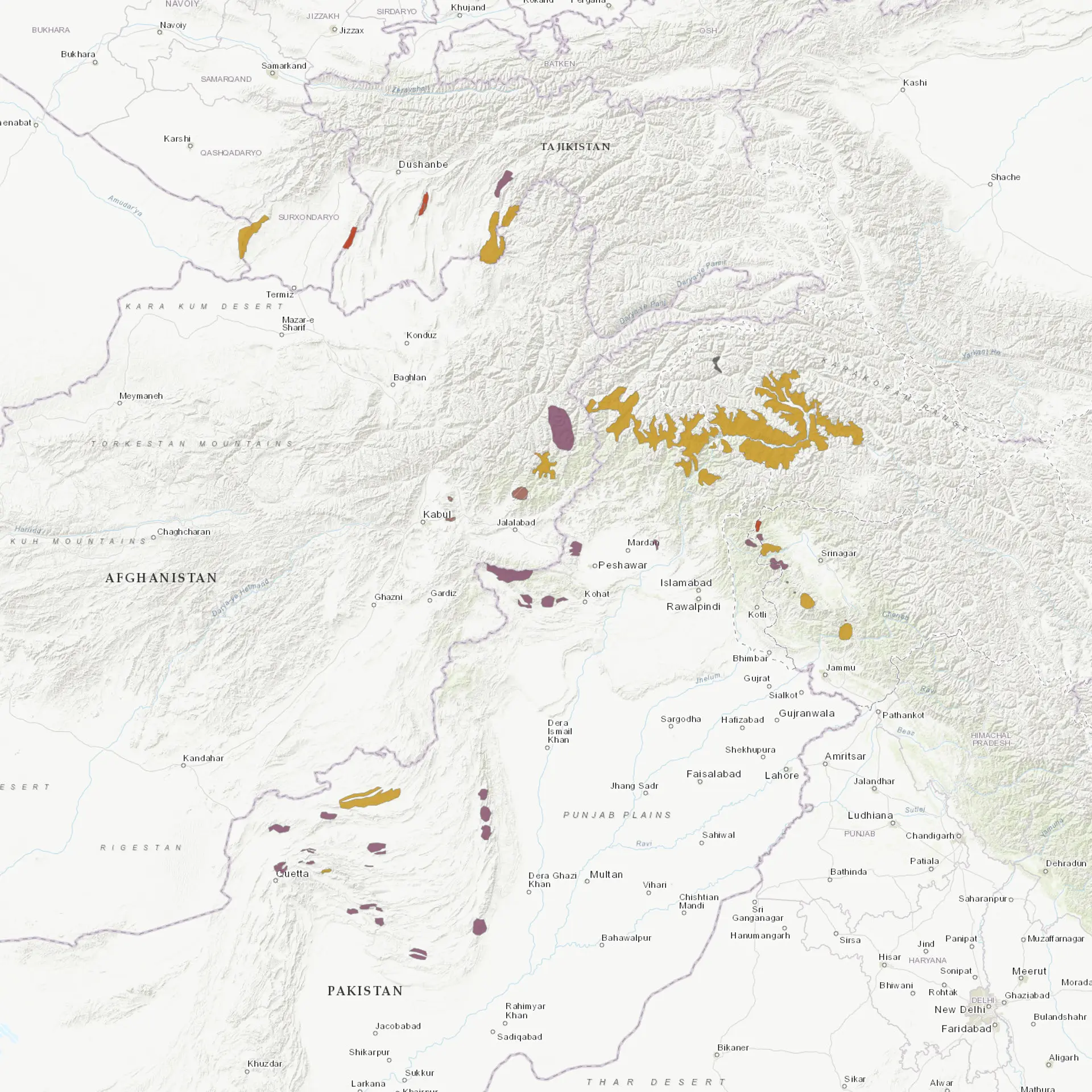Overview
The Markhor (Capra falconeri) is a large wild goat species native to Central and South Asia mountain regions. The Markhor is one of the most distinctive wild goat species known for its impressive corkscrew-shaped horns, which can reach up to 63 inches (160 cm) in males. It inhabits steep, rocky terrain at elevations of 2,000 to 11,500 feet (600 to 3,500 meters), where it is well adapted to the rugged environment. Due to habitat loss, poaching, and competition with domestic livestock, the Markhor is currently listed as Near Threatened by the IUCN.
The Markhor is Pakistan’s national animal, and several conservation efforts have been initiated to protect its dwindling population. Males are significantly larger than females and are known for their striking spiral horns, which are used in dominance battles during the mating season. Their coats change with the seasons, thicker and longer in winter to provide insulation against the cold. Markhors are herbivores, feeding primarily on grasses, leaves, and shrubs, and they are known for their ability to forage on steep slopes that are inaccessible to many other species.
The name “Markhor” comes from the Persian words “mar” (snake) and “khor” (eater), which is believed to refer to the shape of its twisted horns, resembling a coiled serpent. Despite their agile nature, Markhor populations are declining due to human activities, including illegal hunting for their horns and habitat degradation. Conservation programs, particularly community-based trophy hunting initiatives, have helped stabilize some populations in recent years. However, the species remains vulnerable to ongoing environmental and anthropogenic pressures.
Taxonomy
Kingdom
Phylum
Class
Order
Family
Genus
Species
Type
Current distribution:
Historically, Markhors had a much broader range across Central and South Asia, but their distribution has become fragmented due to human activities. Today, they are primarily found in Pakistan, Afghanistan, Tajikistan, and northern India mountainous regions. Some of the largest populations are located in the northern mountains of Pakistan, particularly in the Chitral and Gilgit-Baltistan regions. Smaller populations are scattered across Afghanistan, Tajikistan, and Uzbekistan, though these populations are often isolated due to habitat fragmentation.
Markhors are also present in a few protected areas, such as national parks and wildlife reserves, where conservation efforts have been more successful. Despite these efforts, their overall population remains in decline, and they are often found in only small, fragmented groups. Habitat loss, illegal hunting, and competition with domestic livestock threaten their survival in the wild. Conservation efforts are focused on protecting these fragmented populations and promoting habitat restoration to reconnect isolated groups.
Physical Description:
The Markhor is one of the largest species of wild goat, with males typically weighing between 176 and 240 lbs (80-110 kg) and females being smaller, weighing around 70-110 lbs (32-50 kg). Their most distinctive feature is their long, spiraling horns, which can grow to 40-63 inches (102-160 cm) in males, while females have much shorter horns, reaching 6-10 inches (15-25 cm). Their coat is thick and fuzzy, varying from reddish-brown to gray, and it becomes denser during winter to protect against cold mountain climates. Markhor males also develop a long beard and chest mane, which is particularly pronounced during mating.
Females are generally smaller and lighter than males, with less prominent horns and a shorter, sleeker coat. The Markhor’s legs are muscular and well-adapted for climbing steep and rocky terrain, giving them agility and balance in mountainous regions. Their large, broad hooves are also specialized to grip rocky surfaces, making them adept at traversing cliffs and rugged landscapes. Both sexes have a keen sense of sight and hearing, allowing them to detect predators like snow leopards, wolves, and humans from a distance.

Lifespan: Wild: ~14 Years || Captivity: ~18 Years

Weight: Male: 176-240 lbs (80-110 kg) || Female: 70-110 lbs (32-50 kg)

Length: Male: 53-65 in (135-165 cm) || Female: 49-57 in (125-145 cm)

Height: Male: 32-42 in (81-107 cm) || Female: 28-35 in (71-89 cm)

Top Speed: 30 mph (48 km/h)
Characteristic:
Native Habitat:
Markhors are native to the rugged mountainous regions of Central and South Asia, including parts of Afghanistan, Pakistan, India, Tajikistan, and Uzbekistan. They prefer steep, rocky terrain at elevations between 2,000 and 11,500 feet (600 to 3,500 meters), where they are well-adapted to harsh conditions. These areas often include cliffs, gorges, and alpine forests, providing them with both food and protection from predators. Their ability to traverse difficult terrain helps them avoid predators such as snow leopards and wolves, who are also native to these areas.
Markhors thrive in temperate and subtropical climates, where they experience cold winters and hot summers. In the summer, they move to higher altitudes to escape the heat, while in winter, they descend to lower elevations to avoid heavy snowfall. Depending on the season and location, their habitat includes diverse vegetation, from alpine meadows to dry, rocky outcrops. Conservation of their habitat is critical, as deforestation, overgrazing by livestock, and human encroachment threaten the natural ecosystems they depend on.
Climate Zones:
Biomes:
Biogeographical Realms:
Continents:
Countries:
Diet:
Diet & Feeding Habits:
Markhors are herbivores and primarily grazers, though they may also browse on shrubs and leaves when grass is scarce. Their diet mainly consists of grasses, herbs, leaves, and shoots, which they find in their mountainous habitats’ steep, rocky terrain. They are well-adapted to foraging on slopes that are often inaccessible to other herbivores, using their climbing abilities to reach vegetation at high altitudes. In winter, when snow covers the ground, they often rely on browsing on shrubs, bushes, and tree bark to meet their nutritional needs.
Markhors play an essential role in the ecosystem by controlling the growth of certain plant species in their habitat, helping maintain ecological balance. They often graze during the early morning and late afternoon, resting in shaded or sheltered areas during the hotter parts of the day. Water sources can be scarce in high-altitude environments, so they often rely on moisture from their food to meet their hydration needs. During food scarcity, they may descend to lower altitudes for food.
Mating Behavior:
Mating Description:
Markhors exhibit a polygynous mating system, where dominant males compete to access multiple females during the breeding season. The rutting season occurs from late autumn to early winter, typically from November to January. During this time, males engage in intense combat, using their massive spiral horns to lock and push each other. The strongest males earn the right to mate with the females. After the mating season, males and females typically separate, with males living alone or in bachelor groups.
Gestation lasts about 150-170 days, after which females give birth to one or two kids, usually in late spring or early summer. The young are highly precocial and can stand and walk within hours of birth, though they remain dependent on their mothers for several months. Markhor mothers are highly protective of their offspring and often seek secluded areas to give birth, reducing predation risk. The species is viviparous, with live births and young goats are weaned after 5-6 months.
Reproduction Season:
Birth Type:
Pregnancy Duration:
Female Name:
Male Name:
Baby Name:
Social Structure Description:
Markhors are social animals living in herds that typically consist of females and their offspring, while males are usually solitary or form bachelor groups outside of the breeding season. During the mating season, males compete for dominance, and larger, older males often take control of the herd for breeding purposes. Females and their kids remain in small groups, which helps protect them from predators, as there is safety in numbers. Outside the rutting season, males and females tend to live separately, with males leading a more solitary lifestyle or forming loose groups with other males.
The herd communicates mainly through visual signals, vocalizations, and scent marking. Dominant males use their horns to establish hierarchy and defend their mating rights during the rut. Markhors are highly vigilant and rely on their keen senses to detect predators, using warning calls to alert the group of danger. Social bonds are strongest between mothers and their offspring, which remain with the herd for the first year of their lives.
Groups:
Conservation Status:
Population Trend:
The global population of Markhor is estimated to be between 5,800 and 6,500 individuals, with the majority located in Pakistan. Despite a history of decline due to poaching and habitat loss, recent conservation efforts have led to a slow population recovery. Community-based conservation programs, such as trophy hunting under strict regulation, have provided financial incentives for local communities to protect the species. Markhor populations have shown signs of growth in areas where these programs are in place, but they remain at risk in regions with less active conservation.
In Afghanistan, Tajikistan, and Uzbekistan, populations are smaller and more fragmented, facing similar pressures from poaching and habitat encroachment. These populations are often isolated, which can reduce genetic diversity and increase the risk of inbreeding. Efforts are being made to connect fragmented populations through habitat corridors and protected areas. While the species is listed as Near Threatened, ongoing conservation efforts offer hope for continued population recovery.
Population Threats:
The primary threats to the Markhor are habitat loss, poaching, and competition with domestic livestock for food and space. Illegal hunting for their impressive spiral horns has significantly reduced their numbers, as trophy hunters highly prize Markhor horns. Overgrazing by domestic livestock has also degraded their natural habitat, reducing food availability and forcing the Markhor to compete with cattle, goats, and sheep. Deforestation, driven by human settlement and agricultural expansion, has further fragmented their habitat, isolating populations and making them more vulnerable to local extinction.
Climate change is another emerging threat, as altered weather patterns could further reduce the availability of resources in their already harsh environment. Increased human encroachment into high-altitude areas for tourism and infrastructure development has also disturbed their natural habitat. Predation by snow leopards and wolves poses a natural threat, particularly to young and weak individuals, but human-induced threats remain the primary drivers of population decline. Conservation measures, including establishing protected areas and anti-poaching patrols, are critical for mitigating these threats.
Conservation Efforts:
Markhor conservation has benefited from several community-based initiatives, particularly in Pakistan, where regulated trophy hunting has been introduced. This system allows a limited number of Markhors to be hunted yearly, with most hunting fees reinvested in local conservation projects and community development. These programs have led to increased Markhor populations in regions where they are implemented, as local communities are now incentivized to protect the species from poachers. National parks and wildlife reserves have also been established in Pakistan and other range countries to safeguard key habitats.
Anti-poaching patrols and stricter enforcement of wildlife protection laws have also contributed to stabilizing some Markhor populations. International conservation organizations are working with local governments to create more protected areas and implement sustainable land-use practices. Public awareness campaigns have raised the profile of the Markhor, highlighting the importance of preserving this iconic species. Habitat restoration projects are also underway in some areas to reconnect fragmented populations and improve access to food and shelter.
Additional Resources:
Fun Facts
- The Markhor is Pakistan’s national animal.
- Their name means “snake eater” in Persian, referring to their corkscrew-shaped horns.
- Markhor horns can grow up to 63 inches (160 cm) long in males.
- They are excellent climbers, able to scale cliffs and rocky terrain.
- Markhor males have long beards that grow thicker during the mating season.
- They can leap across wide gaps in rocky landscapes, making them highly agile.
- The species is well-adapted to survive in harsh mountain environments with extreme temperatures.
- Markhors are most active during the early morning and late afternoon.
- Trophy hunting programs in Pakistan have helped increase Markhor populations by reinvesting funds into conservation.
- Unlike many other goats, Markhors are not migratory and tend to remain within a limited home range throughout the year.
















































































